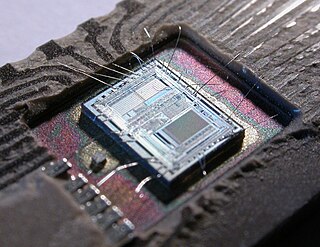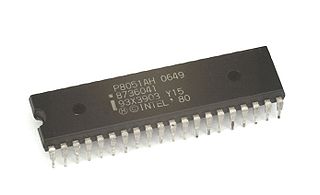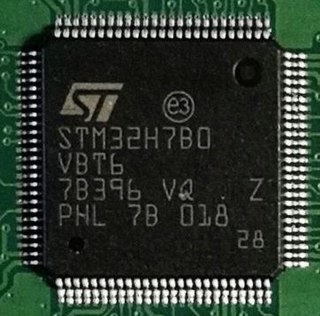
A microcontroller or microcontroller unit (MCU) is a small computer on a single integrated circuit. A microcontroller contains one or more CPUs along with memory and programmable input/output peripherals. Program memory in the form of NOR flash, OTP ROM, or ferroelectric RAM is also often included on the chip, as well as a small amount of RAM. Microcontrollers are designed for embedded applications, in contrast to the microprocessors used in personal computers or other general-purpose applications consisting of various discrete chips.

The Intel MCS-51 is a single chip microcontroller (MCU) series developed by Intel in 1980 for use in embedded systems. The architect of the Intel MCS-51 instruction set was John H. Wharton. Intel's original versions were popular in the 1980s and early 1990s, and enhanced binary compatible derivatives remain popular today. It is a complex instruction set computer, but also has some of the features of RISC architectures, such as a large register set and register windows, and has separate memory spaces for program instructions and data.

The Intel 8085 ("eighty-eighty-five") is an 8-bit microprocessor produced by Intel and introduced in March 1976. It is the last 8-bit microprocessor developed by Intel.

AVR is a family of microcontrollers developed since 1996 by Atmel, acquired by Microchip Technology in 2016. These are modified Harvard architecture 8-bit RISC single-chip microcontrollers. AVR was one of the first microcontroller families to use on-chip flash memory for program storage, as opposed to one-time programmable ROM, EPROM, or EEPROM used by other microcontrollers at the time.
SuperH is a 32-bit reduced instruction set computing (RISC) instruction set architecture (ISA) developed by Hitachi and currently produced by Renesas. It is implemented by microcontrollers and microprocessors for embedded systems.

The Freescale 683xx is a family of compatible microcontrollers by Freescale that use a Motorola 68000-based CPU core. The family was designed using a hardware description language, making the parts synthesizable, and amenable to improved fabrication processes, such as die shrinks.

PIC is a family of microcontrollers made by Microchip Technology, derived from the PIC1640 originally developed by General Instrument's Microelectronics Division. The name PIC initially referred to Peripheral Interface Controller, and is currently expanded as Programmable Intelligent Computer. The first parts of the family were available in 1976; by 2013 the company had shipped more than twelve billion individual parts, used in a wide variety of embedded systems.

The MSP430 is a mixed-signal microcontroller family from Texas Instruments, first introduced on 14 February 1992. Built around a 16-bit CPU, the MSP430 was designed for low power consumption, embedded applications and low cost.

The Blackfin is a family of 16-/32-bit microprocessors developed, manufactured and marketed by Analog Devices. The processors have built-in, fixed-point digital signal processor (DSP) functionality performed by 16-bit multiply–accumulates (MACs), accompanied on-chip by a microcontroller. It was designed for a unified low-power processor architecture that can run operating systems while simultaneously handling complex numeric tasks such as real-time H.264 video encoding.
The XE8000 series is a low-power microcontroller family from XEMICS. Advanced analog features are combined with a proprietary RISC CPU named CoolRISC on all XE8000 devices. The CPU has 8-bits data bus and 22 bits instruction bus. All instructions are executed in 1 clock cycle. The analog features include the ZoomingADC a new type of delta-sigma modulator for analog-to-digital conversion that includes capabilities to amplify and offset the input signal during the acquisition.

The Renesas R8C is a 16-bit microcontroller that was developed as a smaller and cheaper version of the Renesas M16C. It retains the M16C's 16-bit CISC architecture and instruction set, but trades size for speed by cutting the internal data bus from 16 bits to 8 bits. It is available in a number of different versions with varying amounts of flash memory and SRAM.

The Western Design Center (WDC) W65C134S is an 8-bit CMOS microcontroller based on a W65C02S processor core, which is a superset of the MOS Technology 6502 processor.
TLCS is a prefix applied to microcontrollers made by Toshiba. The product line includes multiple families of CISC and RISC architectures. Individual components generally have a part number beginning with "TMP". E.g. the TMP8048AP is a member of the TLCS-48 family.
R8C Tiny is series of low-cost microcontrollers from Renesas. Having 16-bit CPU core M16C with 8-bit bus, the R8C Tiny series offer wide variety of on-chip peripherals include 8-bit Multifunction Timers, UART/Clock Synchronous Serial Interface, Input Capture Timer, Watchdog Timer, etc.
The Mitsubishi 740, also known as MELPS 740, is a series of 8-bit CMOS microcontrollers and microprocessors with an enhanced MOS Technology 6502 compatible core based on the expanded WDC 65C02. The ICs were manufactured by Mitsubishi Electric during the 1980s and 1990s.

The Intersil 6100 is a single-chip microprocessor implementation of the 12-bit PDP-8 instruction set, along with a range of peripheral support and memory ICs developed by Intersil in the mid-1970s. It was sometimes referred to as the CMOS-PDP8. Since it was also produced by Harris Corporation, it was also known as the Harris HM-6100. The Intersil 6100 was introduced in the second quarter of 1975, and the Harris version in 1976.

The 1801 series CPUs were a family of 16-bit Soviet microprocessors based on the indigenous Elektronika NC microarchitecture cores, but binary compatible with DEC's PDP-11 machines. First released in 1980, various models and variants of the series were among the most popular Soviet microprocessors and dominated embedded systems and military applications of the 1980s. They were also used in widely different areas such as graphing calculators and industrial CNCs, but arguably their most well-known use was in several Soviet general-purpose mini- and microcomputer designs like the SM EVM, DVK, UKNC, and BK families. Due to being the CPU of the popular Elektronika BK home computer, used in its late years as a demo machine, as well as the DVK micros that often offered a first glimpse into the UNIX world, this processor achieved something of a cult status among Soviet and then Russian programmers, and to a lesser extent, international programmers.

STM32 is a family of 32-bit microcontroller integrated circuits by STMicroelectronics. The STM32 chips are grouped into related series that are based around the same 32-bit ARM processor core: Cortex-M0, Cortex-M0+, Cortex-M3, Cortex-M4, Cortex-M7, Cortex-M33. Internally, each microcontroller consists of ARM processor core(s), flash memory, static RAM, debugging interface, and various peripherals.

LPC is a family of 32-bit microcontroller integrated circuits by NXP Semiconductors. The LPC chips are grouped into related series that are based around the same 32-bit ARM processor core, such as the Cortex-M4F, Cortex-M3, Cortex-M0+, or Cortex-M0. Internally, each microcontroller consists of the processor core, static RAM memory, flash memory, debugging interface, and various peripherals. The earliest LPC series were based on the Intel 8-bit 80C51 core. As of February 2011, NXP had shipped over one billion ARM processor-based chips.
The MSP432 is a mixed-signal microcontroller family from Texas Instruments. It is based on a 32-bit ARM Cortex-M4F CPU, and extends their 16-bit MSP430 line, with a larger address space for code and data, and faster integer and floating point calculation than the MSP430. Like the MSP430, it has a number of built-in peripheral devices, and is designed for low power requirements. In 2021, TI confirmed that the MSP432 has been discontinued and "there will be no new MSP432 products".














